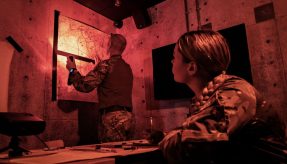
The use of virtual reality within defence has grown rapidly over the last few years. MOD DCB features writer Paul Elliott spoke to Simon Luck, Head of Information Systems at BMT Defence Services, about virtual reality and its impact on defence training.
Virtual reality (VR) solutions are now more realistic than ever before, as well as being even cheaper to produce. As a training technology, VR is seizing the imagination of many across defence. It’s easy to understand why – one brief experience is usually all it takes to appreciate the exceptional immersive qualities that the modern VR environment offers. The Ministry of Defence is keen to exploit its potential and businesses are investing in developing a variety of different solutions.
One of those businesses is BMT Defence Services, which has been producing virtual reality solutions for the past three years. Simon Luck, charged with managing VR projects at BMT Defence Services as Head of Information Systems, is determined to incorporate human factors into the solutions the company is developing because everything in training must be driven from what he calls ‘a human-centric design perspective’.
Mr Luck commented: “Virtual reality only works in a certain set of scenarios. You wouldn’t use it to learn how to break down a weapon, for example, because that’s about teaching muscle memory and you want to be hands-on for that sort of stuff. Virtual reality and immersive training is more suited to familiarisation with standard operating procedures – say, the kind of procedures you would use on a submarine to learn where the valves are and how to interact with them: are they behind pipe works or behind furnishings? That sort of stuff.”
Mr Luck believes virtual reality is a game changer for defence training, and his view is shared widely across the sector with many companies researching the technology to see how it can be implemented into today’s defence training solutions. VR has been around for a number of years, with academic studies on its impact on human behaviour in training dating back to the 1990s. It is in this area of effects where there is currently a lot of renewed interest.
With the technology now more highly advanced, and with increased investment behind it, virtual reality is today at the forefront of people’s minds when considering their training needs. Previously VR required substantial capital investment just to buy the extra computer systems neded to run it. These days VR runs off laptops and small head-mounted displays, so the cost is very much lower. Mr Luck says what’s most important going forward is no longer cost, but developing and delivering the right content. It’s now about producing good content to suit a particular training objective, and not producing content just for the sake of it.

F-35 training simulator
BMT decided to invest in virtual reality about three years ago with the ambition to take its visualisation capability to the next level. The company was doing visualisations in support of its marketing, to better demonstrate to customers what their ship and submarine designs would look like in specific scenarios. When BMT started to use VR it offered the capability to actually take customers on board those designs. For example, the company was able to show what the MARS fleet tanker actually looked like against the Queen Elizabeth Carrier. They were able to run through what the bridge looked like, the operations room, and so forth. The company realised a whole range of activities could be conducted using VR that couldn’t be undertaken quite so effectively before. BMT has since worked with the likes of the Defence Science and Technology Laboratory (Dstl) and other primes to develop the technology and the skills required to deliver it.
The company has just launched its own virtual reality training solution, called Engage. Engage is an immersive platform that helps individuals to train on specific operational procedures. What’s interesting is that BMT has integrated Engage with consumer technology like Fitbits to monitor the physiological effects of training scenarios, such as heart rate, in order to build a robust picture of the training data.
They are also able to do this in real time so the training can be made harder or easier during the scenario. The idea is that this will reduce costs as trainers won’t have to re-run certain training modules based on results. Also, trainees themselves can take control of their learning journey as their data is being captured in one central repository, allowing them to understand what they need to do to get to the next level. There’s a whole psychological perspective emerging as well from this kind of gamification.
It’s interesting to note companies choosing to use consumer technology as part of their virtual reality solutions. Obviously there’s a cost-saving element to this, but one can imagine the benefit trainees derive from using familiar technology.
Mr Luck expanded: “The anticipation and expectation of new recruits going through virtual reality training programmes is a factor as they are going to be using this kind of equipment both in their social life as well as in the working environment. What we’re trying to do is capitalise on the investments that have been made in the commercial sector. The entertainment industry is a hundred billion dollar business; we can’t compete with that so we question how we can make use of those commercial technologies in training and mission planning as well. That’s something we’re looking at with the new immersive technologies.”

BMT’s VR training-solution: Engage.
Commercial technologies and products – things consumers buy and understand – are something the MOD has a particular interest in too. Mr Luck says the MOD has been very open to demonstrations of different types of VR concepts, and is excited to see the kinds of commercial technologies they can utilise within their defence training programmes.
One thing you can always rely on today is that technology will progress fast; and the same is true of defence training requirements. The MOD realises that the commercial constructs and frameworks it has in place need to accommodate changing requirements over the lifetime of a contract. Gone are the days when a ten-year contract could be put in place with the requirement remaining stable; it just doesn’t happen anymore. So businesses need to account for new technologies coming along and training requirements changing, and be more agile in the way contracts are fulfilled as well.
So, how do businesses go about developing a virtual reality solution?
Mr Luck explained: “It’s all about the training objective – that’s what you start with, the operational procedure. So we establish what an individual needs to get from this training and then we’ll look at the human design around that.
“We’ll question whether it is appropriate that it’s done in VR to start with. It may be that they do need to do the training hands-on, so we’ll work with our human factors team within BMT, and we’ll do rapid iterative prototyping. We work in an agile fashion. We don’t just disappear for six months and come back and say ‘here you go’. We want to work very closely with our partners and our customers to design and develop the solution.”
Mr Luck stresses the process of developing solutions such as these is always collaborative. BMT will work with very small niche organisations to fulfil a particular need as well as the likes of Babcock and BAE who might be responsible for the entire platform training solution. The company plans to continue to develop specific solutions for both the MOD directly as well as its primes, partners and other teams that it collaborates with.
If you would like to read more articles like this then please click here








